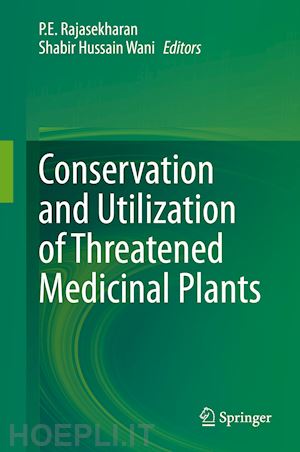
Questo prodotto usufruisce delle SPEDIZIONI GRATIS
selezionando l'opzione Corriere Veloce in fase di ordine.
Pagabile anche con Carta della cultura giovani e del merito, 18App Bonus Cultura e Carta del Docente
Medicinal plants are globally valuable sources of herbal products. Plant-based remedies have been used for centuries and have had no alternative in the western medicine repertoire, while others and their bioactive derivatives are in high demand and have been the central focus of biomedical research. As Medicinal plants move from fringe to mainstream with a greater number of individuals seeking treatments free of side effects, considerable attention has been paid to utilize plant-based products for the prevention and cure of human diseases. An unintended consequence of this increased demand, however, is that the existence of many medicinal plants is now threatened, due to their small population size, narrow distribution area, habitat specificity, and destructive mode of harvesting. In addition, climate change, habitat loss and genetic drift have further endangered these unique species. Although extensive research has been carried out on medicinal and aromatic plants, there is relatively little information available on their global distribution patterns, conservation and the associated laws prevailing.
This book reviews the current status of threatened medicinal plants in light of increased surge in the demand for herbal medicine. It brings together chapters on both wild (non-cultivated) and domestic (cultivated) species having therapeutic values. Thematically, conventional and contemporary approaches to conservation of such threatened medicinal plants with commercial feasibility are presented. The topics of interest include, but not limited to, biotechnology, sustainable development, in situ and ex situ conservation, and even the relevance of IPR on threatened medicinal plants. We believe this book is useful to horticulturists, botanists, policy makers, conservationists, NGOs and researchers in the academia and the industry sectors.
Section 1: Genetic Resources of threatened medicinal plants at crossroads
1 Threatened medicinal plants distribution and diversity and utilisation
P.E. Rajasekharan and K. Haridasan, Indian Institute of Horticultural Research, India
2 Identification of threat status for medicinal plants: tools and methods
Sanjay M Molur, Zoo Outreach Organization, India
3 Geospatial technologies for threatened medicinal plants conservation
N. Sivaraj, National Bureau of Plant Genetic Resources, India
4 Information and database for threatened medicinal plants
N. Venugopal, Foundation of Revitalization of Local Health Traditions, India
5 Utilization of threatened medicinal plants as a livelihood option
Madhav Karki, Centre for Green Economy Development, Nepal
Section 2: Conservation of threatened medicinal plants: concepts and practices
6 Conservation of threatened medicinal plants: Concepts and current practices
D. K. Ved, TransDIsciplinary University, India
7 In situ conservation of threatened medicinal plants: concepts and practices
Ranjith Mahindapala, International Union for Conservation of Nature, India
8 Ex situ conservation: seed banks, FGB and botanical garden
K. Haridasa, Foundation for revitalization of Local Health Traditions, India
9 Biotechnology for conservation and multiplication of threatened medicinal plants
P.E. Rajasekharan, Indian Institute of Horticultural Research, India
10 Cryopreservation of threatened medicinal plants
Neelam Sharma, National Bureau of Plant Genetic Resources, India
11 Cultivation of threatened medicinal plants as a tool for conservation
Abdul Kareem, Foundation for revitalization of Local Health Traditions, India
12 Utilization of threatened of medicinal plants: problems, progress and prospects
Anil Kumar, M.S. Swaminathan Research Foundation, India
Section 3: Characterization and evaluation of threatened medicinal plants
13 Morphological characterization of threatened medicinal plants
Hima Bindu, Indian Institute of Horticultural Research, India
14 Chemical characterization of threatened medicinal plants
V.K. Rao, Indian Institute of Horticultural Research, India
15 Genomics and Molecular characterization of threatened medicinal plants
Sarah O'Connor, John Innes Centre, UK
16 Drugs from threatened medicinal plants
D. D. Soejarto, University of Illinois at Chicago, USA
Section 4: Case studies on different threatened medicinal plants distributed in different agroecological regions
17 High altitude threatened medicinal plants
Ravinder Raina, Y. S. Parmar University of Horticulture and Forestry, India
18 Threatened plants of Western Ghats
N.Sasidharan, Kerala Forest Research Institute (KFRI), India
19 Threatened medicinal plants of Himalayan regions
Hemant K. Badola, G.B. Pant Institute of Himalayan Environment and Development, India
20 Threatened medicinal plants from the other regions of the world
Sarah A. Laird, University College London, UK
Section 5: Legal aspects of threatened medicinal plants
23 Intellectual Property Rights related to threatened medicinal plants
P.E. Rajasekharan, Indian Institute of Horticultural Research, India
24 Importance of Traditional knowledge related to medicinal plants its utilisation and protection
Gerry Bodeker, Mathematical Institute, Oxford
25 Access and benefit sharing in threatened medicinal plants
Suneetha M. Subramanian, United Nations University, Japan











Il sito utilizza cookie ed altri strumenti di tracciamento che raccolgono informazioni dal dispositivo dell’utente. Oltre ai cookie tecnici ed analitici aggregati, strettamente necessari per il funzionamento di questo sito web, previo consenso dell’utente possono essere installati cookie di profilazione e marketing e cookie dei social media. Cliccando su “Accetto tutti i cookie” saranno attivate tutte le categorie di cookie. Per accettare solo deterninate categorie di cookie, cliccare invece su “Impostazioni cookie”. Chiudendo il banner o continuando a navigare saranno installati solo cookie tecnici. Per maggiori dettagli, consultare la Cookie Policy.